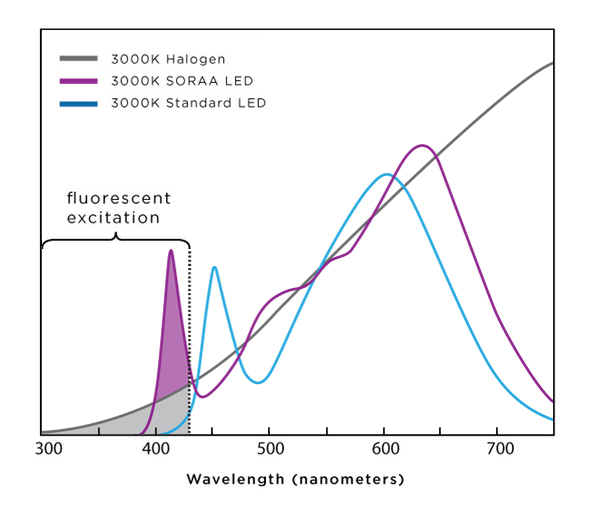Stephenj37826
Well-Known Member
Where is the ceiling to umol/j in phosphor leds? If I'm understanding the way phosphor conversion happens then we are going to hit a ceiling somewhere in the range of 3.72 umol/j.......... Am I missing something?
3.72umol/J from the blue source and after the phosphor conversion we have around 4.7umol/J....damned physicsI base this assumption on the the QER if the photon source. Royal blue QER is ~3.72. If we are only starting with that number then it seems impossible to achieve a higher photon count.

"The use of cadmium is generally decreasing due to its toxicity (it is specifically listed in the European Restriction of Hazardous Substances[3]) and the replacement of nickel-cadmium batteries with nickel-metal hydride and lithium-ion batteries."which are tiny semiconductor beads made of layers of (usually) cadmium and selenium
Nanoco (with DOW) is a pioneer in this area, but Quantum Materials and Nanosys are still making tons of Cd containing QDs. On the bright side the Cd is sequestered in a durable shell, but the toxicity once released is well documented."The use of cadmium is generally decreasing due to its toxicity (it is specifically listed in the European Restriction of Hazardous Substances[3]) and the replacement of nickel-cadmium batteries with nickel-metal hydride and lithium-ion batteries."
https://en.wikipedia.org/wiki/Cadmium
Cadmium-free quantum dots
http://www.nanocotechnologies.com/what-we-do/products/cfqd-quantum-dot-films
So the 4.7 umol/j is qer of roughly 3000k. This is the photon count of 3000k spectrum per joule of light output. One of two things will/is occur/ing (A we will hit a ceiling of 3.72 umol) (B the phosphorus is not simply "peeling" energy off each respective photon but rather redistributing the energy)3.72umol/J from the blue source and after the phosphor conversion we have around 4.7umol/J....damned physics
I've known about these for quite a while. Surprisingly there is a grow light that actually uses quantum dot tech now. We have been in a side by side with them for about 6 months now. So far the cxb3590 3500k @ 1.4a has about the same yield as 80 watts of this quantum dot grow light. Also to consider is will this tech still suffer from my proposed "bottleneck"As to phosphors there are things called quantum dots (QDs) which are tiny semiconductor beads made of layers of (usually) cadmium and selenium that at least one company QD Vision / Color IQ is trying to add to display screens. Traditionally white LEDs were YAG:Ce phosphors combined with nitride-based blue LEDs, but its not usually the (blue light -> Phosphor ->white light) reaction that's limiting, its the initial (electricity -> LED-> blue light) process that's currently ~15-20% efficient, I believe.
Check this hybrid QD/LED (device B) emission spectra:

the current QD/LEDs are being sold for having a much broader color gamut, lots of IR and a higher CRI, not really whats needed in Ag stuff.
Are we gonna get some UV based leds instead of royal blue someday ?
would love to see some shorter wavelength Blues\UVA in my lighting spectrum without adding monos.
Are we gonna get some UV based leds instead of royal blue someday ?
would love to see some shorter wavelength Blues\UVA in my lighting spectrum without adding monos.
I meant white leds based on a uv diode instead of a royal blue diode.Nichia has you covered lol.
How efficient is UV currently.I meant white leds based on a uv diode instead of a royal blue diode.
Cree reports that the LED efficacy was measured at 303 lumens per watt, at a correlated color temperature of 5150 K and 350 mA. Standard room temperature was used to achieve the results.every tech has a ceiling
cree is demonstrating 300 lm/W in the lab, what does that crunch out to assuming they are talking say 4000K light?
The durability of the QDs (where I've seen data) hasn't been up to the std phosphors, they quote some 2000h lifetime at 110C but at reg temps they have been inferior. Maybe this has changed but it was of note when I saw it. QDs were "the next big thing" about year 2000 but many of the companies folded, they seem to have followed the "Gartner Hype Curve" but may be out of the troughI've known about these for quite a while. Surprisingly there is a grow light that actually uses quantum dot tech now. We have been in a side by side with them for about 6 months now. So far the cxb3590 3500k @ 1.4a has about the same yield as 80 watts of this quantum dot grow light. Also to consider is will this tech still suffer from my proposed "bottleneck"
Its true this tech will get better over the next few years as Samsung's newest tech uses quantum dot. Also I think Sony and some others are going in that direction as well.

Where you been bro? Actually IDK if these would be worth it for our thing but you could talk to $ORRA about something custom. Gotta love the beam angles on these. GaN on GaN in da house! Actually West NY in da house!*Are we gonna get some UV based leds instead of royal blue someday ?
would love to see some shorter wavelength Blues\UVA in my lighting spectrum without adding monos.
probably too pricey but this is pretty cool.Where you been bro? Actually IDK if these would be worth it for our thing but you could talk to $ORRA about something custom. Gotta love the beam angles on these. GaN and GaN in da house! Actually West NY in da house!*
http://www.soraa.com/products/23-PAR38
https://res.cloudinary.com/soraa/raw/upload/v1460478841/resources/specifications/par38-120v.zip
!

